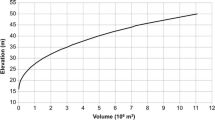Abstract
In this study, a two-dimensional hydraulic routing model was applied to a sudden failure scenario for the Atasu Dam in Trabzon, Turkey. The goal was to simulate spreading and propagation of a dam break flood wave along a narrow valley into a downstream city center with many buildings. Flow properties along the downstream were routed according to diffusive and dynamic wave models represented by Saint–Venant equations. Maximum flow depth, maximum flow velocity, and time moment of the maximum flow depth maps are shown in a Geographic Information System environment. The results predict that flow depths could reach approximately 8 m in the residential area, and this would be achieved approximately 32 min after the dam-break event. Houses in a large section of the city center would be under the maximum flow depths. The results of this study demonstrate that these two approaches can determine potential risk areas of a floodplain due to natural hazards and facilitate preparation of emergency action plans.












Similar content being viewed by others
Data availability
Corresponding author contact.
References
Albu LM, Enea A, Iosub M, Breabăn IG (2020) Dam Breach Size Comparison for Flood Simulations. A HEC-RAS Based GIS Approach for Drăcșani Lake Sitna River Romania. Water 12(4):1090
Azeez O, Elfeki A, Kamis AS, Chaabani A (2020) Dam break analysis and flood disaster simulation in arid urban environment: the Um Al-Khair dam case study, Jeddah. Saudi Arabia Nat Hazards 100(3):995–1011
Bhandari M (2017) One-Dimensional (1D) & Two-Dimensional (2D) Dam Break Analysis and Comparison of Different Breaching Parameters Using HEC-RAS. Southern Illinois University at Carbondale, Carbondale, Illinois
Biscarini C, Di Francesco S, Manciola P (2010) CFD modelling approach for dam break flow studies. Hydrol Earth Syst Sci 14(4):705
Chow VT (1988) Applied Hydrology. McGraw-Hill, New York
Dai S, He Y, Yang J, Ma Y, Jin S, Liang C (2020) Numerical study of cascading dam-break characteristics using SWEs and RANS. Water Supply 20:348–360
Froehlich DC (1995) Peak outflow from breached embankment dam. J Water Resour Plan Manag 121(1):90–97
Gallegos HA, Schubert JE, Sanders BF (2009) Two-dimensional, high-resolution modeling of urban dam-break flooding: A case study of Baldwin Hills California. Adv Water Resour 32(8):1323–1335
Garcia-Navarro P, Fras A, Villanueva I (1999) Dam-break flow simulation: some results for one-dimensional models of real cases. J Hydrol 216:227–247
Gee DM, Brunner GW (2005) Dam break flood routing using HEC-RAS and NWS-FLDWAV. World Water Environ Resour Congr Anchorage. 9(1):3634–3643
Haltas I, Tayfur G, Elci S (2016) Two-dimensional numerical modeling of flood wave propagation in an urban area due to Ürkmez dam-break, İzmir Turkey. Nat Hazards 81(3):2103–2119
Hu H, Zhang J, Li T, Yang J (2020) A simplified mathematical model for the dam-breach hydrograph for three reservoir geometries following a sudden full dam break. Nat Hazards 102:1515–1540
Ismail H, Ann Larocque L, Bastianon E, Hanif CM, Imran J (2020) Propagation of tributary dam-break flows through a channel junction. J Hydraul Res. https://doi.org/10.1080/00221686.2020.1744753
Issakhov A, Zhandaulet Y (2020) Numerical study of dam break waves on movable beds for complex terrain by volume of fluid method. Water Resour Manage 34(2):463–480
Kocaman S (2007) Experimental and theoretical investigation of dam break problem. Ph.D. Thesis, Cukurova University, in Turkish, p.286
Kocaman S, Ozmen-Cagatay H (2015) Investigation of dam-break induced shock waves impact on a vertical wall. J Hydrol 525:1–12
Kocaman S, Güzel H, Evangelista S, Ozmen-Cagatay H, Viccione G (2020) Experimental and numerical analysis of a dam-break flow through different contraction geometries of the channel. Water 12(4):1124
Marangoz HO (2020) Modelling of Dam Break Induced Flood Wave Using Diffusion and Momentum Wave Approaches, Ms Thesis, Recep Tayyip Erdogan University, in Turkish, p.164
Munoz DH, Constantinescu G (2020) 3-D dam break flow simulations in simplified and complex domains. Adv Water Resour. https://doi.org/10.1016/j.advwatres.2020.103510
Ozmen-Cagatay H, Kocaman S (2010) Dam-break flows during initial stage using SWE and RANS approaches. J Hydraul Res 48(5):603–611
Palu MC, Julien PY (2020) Test and improvement of 1D routing algorithms for dam-break floods. J Hydraul Eng 146(6):04020043
Pilotti M, Milanesi L, Bacchi V, Tomirotti M, Maranzoni A (2020) Dam-break wave propagation in Alpine valley with HEC-RAS 2D: experimental cancano test case. J Hydraul Eng 146(6):05020003
Staroszcyk R (2010) Simulation of dam-break flow by a corrected smoothed particle hydrodynamics method. Arch Hydro- Eng Environ Mech 57:61–79
Wang Y, Liang Q, Kesserwani G, Hall JW (2011) A 2D shallow flow model for practical dam-break simulations. J Hydraul Res 49(3):307–316
Wang B, Chen Y, Wu C, Dong J, Ma X, Song J (2016) A semi-analytical approach for predicting peak discharge of floods caused by embankment dam failures. Hydrol Process 30(20):3682–3691
Wurbs RA (1987) Dam-breach flood wave models. J Hydraul Eng 113(1):29–46
Zhang S, Li W, Jing Z, Yi Y, Zhao Y (2017) Comparison of three different parallel computation methods for a two-dimensional dam-break model. Math Probl Eng. https://doi.org/10.1155/2017/1970628
Zoppou C, Roberts S (2000) Numerical solution of the two dimensional unsteady dam break. Appl Math Model 24:457–475
Funding
Not applicable.
Author information
Authors and Affiliations
Corresponding author
Ethics declarations
Conflicts of interest
The authors declare that they have no conflict of interest.
Additional information
Publisher's Note
Springer Nature remains neutral with regard to jurisdictional claims in published maps and institutional affiliations.
Rights and permissions
About this article
Cite this article
Marangoz, H.O., Anilan, T. Two-dimensional modeling of flood wave propagation in residential areas after a dam break with application of diffusive and dynamic wave approaches. Nat Hazards 110, 429–449 (2022). https://doi.org/10.1007/s11069-021-04953-w
Received:
Accepted:
Published:
Issue Date:
DOI: https://doi.org/10.1007/s11069-021-04953-w




